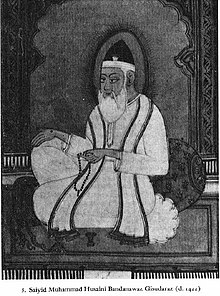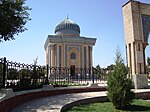Khwaja Banda Nawaz Gesudaraz | |||||
|---|---|---|---|---|---|
 Portrait of Bande Nawaz | |||||
| Personal | |||||
| Born | Syed Muhammad al-Hussaini 7 August 1321 | ||||
| Died | 1 November 1422 (aged 101) | ||||
| Religion | Islam | ||||
| Era | Islamic golden age | ||||
| Denomination | Sunni | ||||
| Jurisprudence | Hanafi | ||||
| Creed | Maturidi [1] | ||||
| Main interest(s) | Sufism | ||||
| Muslim leader | |||||
Influenced by | |||||
Influenced | |||||
| |||||
Syed Muhammad ibn Yousuf al-Hussaini (7 August 1321 − 10 November 1422)[ citation needed], commonly known as Khwaja Banda Nawaz Gesudaraz, was a Hanafi Maturidi scholar and Sufi saint from India of the Chishti Order.
Gaisu Daraz was a disciple and then successor of Sufi saint Nasiruddin Chiragh Dehlavi. When he moved to Daulatabad around 1400, owing to the attack of Timur on Delhi, he took the Chishti Order to South India. [2] He finally settled down in Gulbarga, at the invitation of Bahmani Sultan, Taj ud-Din Firuz Shah. [3]
In Delhi
Khwaja Banda Nawaz left Delhi on December 17, 1398, because the city was under siege by Timur and its fall was imminent. [4]
Works
Bande Nawaz wrote 195 books in Arabic, Persian and Urdu. [3] He also composed a book on the Prophet of Islam titled Miraj-al Ashiqin for the instruction of the masses in Dakhni, a South Indian branch of the Urdu language. He was the first Sufi to use this vernacular which was elaborated upon by many other Sufi saints of South India in later centuries. [5] He wrote many treatises on the works on Ibn Arabi and Suhrawardi, which made the works of these scholars accessible to Indian scholars and played a major role in influencing later mystical thought. [6] Other books authored are Qaseeda Amali and Adaab-al-Mureedein.
Urs

His death anniversary takes place on 15, 16 and 17 Dhu al-Qadah at the Bande Nawaz mausoleum in Gulbarga. Several hundred thousand people from different religions gather to seek blessings. [3]
In popular culture
Indian Muslim social films revolving around the saint and his dargah have been made. These include: Sultan E Deccan: Banda Nawaz (1982) by Malik Anwar, Banda Nawaz (1988) by Saini. [7]
See also
References
- ^ Nawaz, Bande. Tafseer-Al-Multaqat. Vol. 1. Maktabah Nafais al-Quran. p. 6.
- ^ Jihad in the East: A Crescent Over Delhi The Shade of Swords: Jihad and the Conflict Between Islam and Christianity, by M. J. Akbar. Routledge, 2002. ISBN 0-415-28470-8. Page 111.
- ^ a b c Urs-e-Sharief of Khwaja Bande Nawaz in Gulbarga from tomorrow " The Hindu", 27 November 2007.
- ^ Eaton, Richard (2005). A Social History of The Deccan 1300–1761, Eight Indian Lives. New Delhi: Cambridge University Press. ISBN 978-0-521-51442-2.
- ^ Mystical Dimensions of Islam By Annemarie Schimmel, Pg 351
- ^ Irfan Habib, S. (October 2002). "Book reviews and notices : M.T. ANSARI, ed., Secularism, Islam and modernity. Selected essays of Alam Khundmiri. New Delhi: Sage Publications, 2001. 308 pp. Notes, index. Rs. 250 (paperback)". Contributions to Indian Sociology. 36 (3): 568–570. doi: 10.1177/006996670203600313. S2CID 220847929.
- ^ Screen World Publication's 75 Glorious Years of Indian Cinema: Complete Filmography of All Films (silent & Hindi) Produced Between 1913-1988. Screen World Publication. 1988. p. 85.
Bibliography
- Askari, Syed Hasan, Tazkira-i Murshidi—Rare Malfuz of the 15th-Century Sufi Saint of Gulbarga. Proceedings of the Indian Historical Records Commission (1952).
- Hussaini, Syed Shah Khusro, Gisudaraz on Wahdat al-Wujud. Studies in Islam 19 (1982), pp. 233–45.
- Hussaini, Syed Shah Khusro, Sayyid Muhammad al-Husayni Gisu Daraz: On Sufism Delhi: Idarah-i Adabiyat-i Delli, 1985.
- Hussaini, Syed Shah Khusro, Shuhud vs. Wujud: A Study of Gisudiraz Islamic Culture 59 (1985), pp. 323–39.
- Siddiqi, Mohd. Sulaiman, Syed Mohd. al-Husaini Gisudaraz Islamic Culture 52 (1978), pp. 173–84.
- Syed Shah Khusro Hussaini, "Gulbarga: Dargha of Hazrat Khwaja Bandanawaz Gisudaraz" in Mumtaz Currim, George Michell (Eds.), Darghas. Abodes of the Saint, Bombay, The Marg Foundation, 2004, 152 p. (ISBN 978-8-185-02665-7), p. 120-135
- 1321 births
- 1422 deaths
- Chishti Order
- Writers from Karnataka
- Indian Sufi religious leaders
- Indian Sufi saints
- Urdu-language writers from India
- Scholars from Karnataka
- 14th-century Indian scholars
- 15th-century Indian scholars
- People from Kalaburagi
- Supporters of Ibn Arabi
- Hanafis
- Maturidis
- 14th-century Indian non-fiction writers
- 14th-century Indian people
- 14th-century Indian philosophers
- 14th-century Indian writers
- 15th-century Indian non-fiction writers
- 15th-century Indian people
- 15th-century Indian philosophers
- 15th-century Indian writers
- Chishtis
- Sunni Sufis
